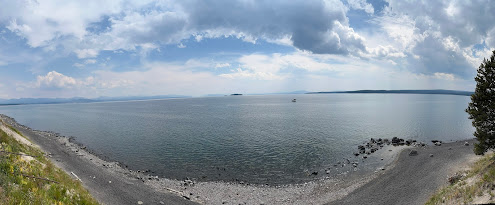Summer television reruns aren't my favorite. I keep seeing the ads for the new season, and I'm looking forward to more choices for evening television viewing. (We are not in a prime location for streaming, so I'm limited to the "million" or so channels from my Dish Network. Yes, I know that's ironic, coming from someone who grew up with four TV stations - ABC, NBC, CBS and PBS. My, how times have changed!)
Anyway, we had a "rerun" to Yellowstone during our trip. I had someone ask me why we'd want to go back. There were several factors. Even though we'd spent 12 hours in Yellowstone in 2011, we didn't see it all. If you're driving to Glacier, you have to figure out some way to get back home. Why not include the beauty of Yellowstone in the travel itinerary?
 |
| The Madison River |
This time, we drove through different areas than we had the first time. Though we repeated the Grand Canyon of Yellowstone, we didn't visit Old Faithful, Blue Star Spring or Grand Prismatic Spring on this latest trip.
Yellowstone has been a national park since 1872. But nature changes. It changes from day to day, much less since our visit 13 years ago or when it was founded 152 years ago ... and beyond.
 |
| Gibbon Falls |
This was Beryl Spring. The violent agitation of the water is due to volcanic gases, mostly steam. The temperature of the water is usually a few degrees below boiling. It's one of the hottest springs in Yellowstone.
We took a short hike to the Artist's Paintpots.
The shot below wasn't nearly as pretty, but it shows the aftermath of all that boiling and bubbling.
We saw more geysers at the Norris Geyser Basin. It is Yellowstone's most dynamic - the hottest, most acidic and most dynamic geyser basin. It's part of one of the world's largest active volcanoes (according to a sign at the park.)
 |
| Norris Geyser Basin |
It was named for Philetus W. Norris, who served as superintendent of Yellowstone from 1877 to 1882. He recorded the area's hydrothermal features in detail and also oversaw construction of some of the park's first roads, which still remain in the Grand Loop Road.
The next day, our trek along Blacktail Plateau Drive took us off the beaten path and onto a gravel road. (Our car is used to that.)
We only saw two other cars along the gravel road, which was a nice change of pace.
But, soon enough, we were back to the main road and heading toward some of the better known attractions - like Tower Creek. About 50 million years ago, volcanoes in Yellowstone and surrounding areas started to erupt, burying the land under volcanic rock. These ancient Eocene volcanoes left their mark with darker vertical cliffs that stretch up from the river.
The 132-foot drop of Tower Creek, framed by eroded volcanic pinnacles has been documented by park visitors from the earliest trips of Europeans into the Yellowstone region. It has inspired numerous artists, including Thomas Moran. His painting of Tower Fall played a role in establishing Yellowstone National Park in 1872.
Most of this visit's stops at Yellowstone were new to us. But the Grand Canyon of the Yellowstone was our favorite spot when we visited the park in 2011. Unlike the summer reruns on network television, this second viewing was just as awe-inspiring as the first.
The canyon varies from 800 to 1,200 feet in depth and from 1,500 to 4,000 feet in width. It's about 24 miles long.
Hot spring activity has continued through the ages, altering the lava rock to produce varied colors which are largely due to different iron compounds.
We also saw Roaring Mountain ...
... and Yellowstone Lake. (It is huge.)We packed as much as we could into our day and a half. I'm sure we didn't see all of it this time either.
Visitors at Yellowstone seemed to form the United Nations of the world. As we walked around after supper in West Yellowstone, we heard many different languages - probably more that weren't English. But is it any wonder that the natural beauty attracts people from all around the world?
It wasn't just the different countries represented. The National Parks also bring together people from all different parts of the country and different lifestyles. There were plenty of families with little boys skipping rocks into lakes. (It does seem little boys and rock skipping are universal. I'm not being sexist. Boys just seem to gravitate to the rock throwing more, in my observations.) I sat on a bench with a woman about my age who lives in New York City. She couldn't believe how "isolated" and "remote" everything was. I'm looking around at more people than I usually see in a week and thinking about how different our daily lives are. But we still had a wonderful visit while sitting on a bench. I "met" another woman while standing in line, waiting for a bathroom at Glacier. She said, "They say everyone has a twin somewhere in the world. I know yours." Ironically, my "twin's" name was Jill, and I told the lady that I had a daughter named Jill (who looks nothing like me). I happened to see her a couple more times, and each time, she said, "Hi, Kim!"
It really is a small world. And it's a beautiful world, too.




















What an absolutely stunning park to visit. So much more than I realised.
ReplyDeleteWe still didn't see it all. And, of course, nature changes every day, so the scenes are never identical. I would recommend it!
Delete